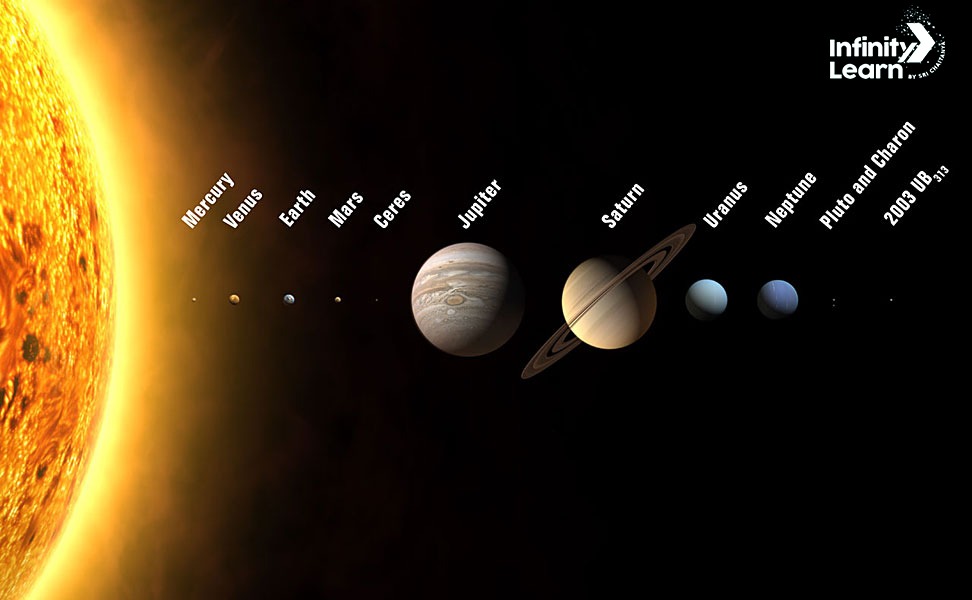
Courses

By Shailendra Singh
|
Updated on 21 Mar 2025, 10:29 IST
Solar System Diagram: A Solar System Diagram is a visual representation of our solar system. It shows the Sun at the center with planets orbiting around it. This diagram helps us understand the positions and distances of planets, moons, and other celestial objects. It is a useful tool for learning about the structure of our solar system and the relationships between different astronomical bodies.
A solar system is a collection of celestial objects bound together by gravity, centered around a star. In our case, the solar system revolves around the Sun. It includes planets, moons, asteroids, comets, and other space debris that orbit the Sun. The Sun’s gravity keeps these objects in their orbits, creating a dynamic and interconnected cosmic environment. Each planet and moon follows its own path, but all are part of the same gravitational system. The study of solar systems helps us understand how stars and planets form and interact in the universe.

Creating a diagram of the solar system can be both educational and visually engaging. Here are some pointers to help you draw a solar system diagram:
1. Gather Reference Materials
Tip: Look for images and diagrams from reputable sources like NASA, space agencies, or educational websites to understand the layout and relative sizes of the planets and other celestial objects.
2. Choose Your Drawing Medium
Tip: Decide whether you’ll use traditional materials like paper and pencils or digital tools like graphic design software for your diagram.
3. Plan the Layout
Tip: Sketch the basic structure of the solar system, positioning the Sun at the center and arranging the planets in their correct orbital paths.
4. Draw the Sun
Tip: Start with a large circle in the center for the Sun. Add details like sunspots or solar flares for more realism.

5. Add the Planets
Tip: Draw circles for each planet, placing them at appropriate distances from the Sun. Use different sizes for planets to represent their relative diameters (though not to scale).
6. Illustrate Orbital Paths
Tip: Draw concentric circles or ellipses around the Sun to represent the orbits of the planets. Indicate the direction of orbit with arrows if desired.
7. Label Each Planet
Tip: Clearly label each planet with its name, and optionally include information like average distance from the Sun or unique features.
8. Add Moons and Other Features
Tip: Include the major moons around planets and the asteroid belt between Mars and Jupiter if you wish to add more detail.
9. Use Color and Texture
Tip: Use colors to differentiate between the Sun, planets, and space. Consider adding textures or shading to represent planetary surfaces or atmospheric features
10. Review and Edit
Tip: Check your diagram for accuracy and make sure all labels and details are correct. Edit for clarity and visual appeal.

Before diving into the diagram, let’s explore the key components that make up our solar system:
The Sun: The central star of our solar system, the Sun is the source of light and heat for all the planets and other objects. It contains more than 99% of the solar system’s total mass.
Planets: There are eight major planets that orbit the Sun. They are, in order from the Sun:
Dwarf Planets: These are smaller than the main planets but still orbit the Sun. Pluto, Eris, Haumea, Makemake, and Ceres are well-known examples.
Moons: Many planets have natural satellites, or moons, that orbit around them. For example, Earth has one moon, while Jupiter has more than 70 moons.
Asteroids: These rocky bodies mostly orbit the Sun in the asteroid belt between Mars and Jupiter.
Comets: Comets are icy bodies that release gas and dust, forming a glowing coma and a tail when they approach the Sun.
Kuiper Belt and Oort Cloud: The Kuiper Belt is a region beyond Neptune filled with icy bodies. The Oort Cloud is a distant, spherical shell of icy objects surrounding the solar system.
A solar system diagram helps students visualize the structure of the solar system, including the positions and relationships of the Sun, planets, moons, asteroids, and comets. It serves as a visual aid to make abstract concepts more understandable and to support educational activities like labeling, matching, and discussions.
A typical solar system diagram includes the Sun at the center, eight planets arranged in orbit around the Sun, the asteroid belt between Mars and Jupiter, comets with their elliptical paths, dwarf planets beyond Neptune, and sometimes the Kuiper Belt and Oort Cloud as distant regions.
Diagrams are useful as they show a visual layout of the solar system, helping students grasp the positions and sizes of different objects. Visual tools also aid memory and make learning more interesting.
Teachers can use solar system diagrams for a range of classroom activities such as interactive lessons, group projects, and quizzes. Diagrams can also be used as visual aids during lectures or as part of homework assignments where students create or analyze their own diagrams.